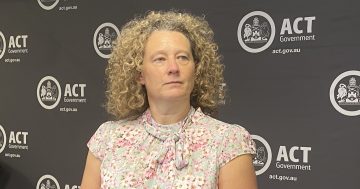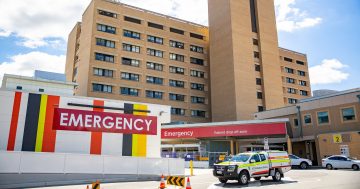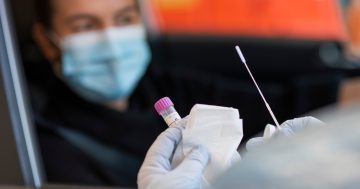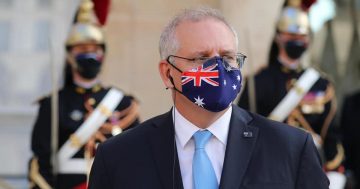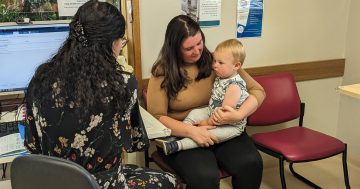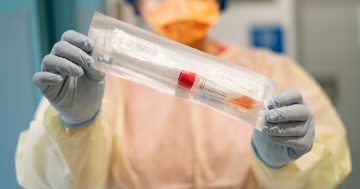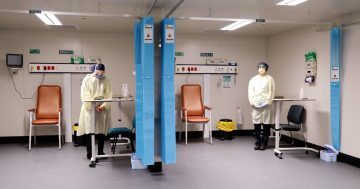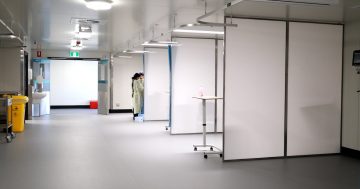
Chief Minister Andrew Barr defended the changes to retail trade, saying it was an adjustment made based on high vaccination rates, not on what the NSW Government is doing. Photo: Michelle Kroll.
UPDATED 2:30 pm: Chief Minister Andrew Barr has today been forced to defend the changes to the ACT’s pathway forward triggered by hitting the 12-plus 80 per cent full vaccination target yesterday.
The resumption of in-person retail from 11:59 pm on Thursday (21 October), subject to in-store density limits, has brought the ACT’s approach more in line with that of its surrounding jurisdiction, NSW.
Further alignment with NSW around interstate travel is foreshadowed to take place on 1 November. At this stage, it appears free travel will be possible both ways – so NSW residents can enter the Territory from Sydney and the rest of NSW and vice versa for Canberrans.
There may still be a need for targeted hotspots, the Chief Health Officer, Dr Kerryn Coleman, said today.
An updated version of the ACT’s pathway forward has also been posted on the ACT Government’s COVID-19 website.
As well as the already-noted changes on 29 October, according to the pathway, from 26 November, facemasks will only be necessary for high-risk indoor settings, and there will no longer be a limit on visitors at home or outdoor gatherings.
All retail will be permitted to operate with one person per two square metres. Density limits on hairdressers and other personal services will also be relaxed to 25 or one person per two square metres.
Capacity limits for hospitality venues, food courts, gym classes and cinemas will also be relaxed. Dancing and drinking and eating while standing up will also be permitted.
Lastly, ticketed events will be back for up to 1000 people and organised sport, and swimming pools, galleries, museums, cultural institutions, historic sites and outdoor attractions can all return.
As has been seen today, the pathway is subject to change.
“Nothing is certain with COVID-19. We give the best possible advice we can when situations change,” Mr Barr said.
“Not everything is under our control, and there are many factors which are external to us – either what the virus is doing or what other governments are doing.”
Mr Barr said the ability of Canberrans to simply head to Queanbeyan to go to Kmart had not been at the forefront of his mind when making decisions.
Mr Barr today said the primary driver for the reopening of retail on Friday had been the Territory’s high vaccination rates. However, he did acknowledge the “degree of confusion” from NSW’s announcements on Friday, including the overseas arrivals debacle which saw the Prime Minister forced to step in.
“That sort of thing doesn’t help the matter, and we’ve now doubled down on our interactions with NSW to try to get some greater clarity and to align where it’s sensible and meets our requirements around public health and safety,” Mr Barr said.
Mr Barr was also critical of the length of time between National Cabinet meetings, saying there probably is a need for a meeting soon.
The next National Cabinet meeting is not due until November, although it seems the Prime Minister may now miss it due to his attendance at COP26 in Glasgow.
The adjustments to retail were welcomed by the Opposition, who described it as a “common sense” approach. Canberra Liberals leader Elizabeth Lee said the adjustments to retail trade should have been implemented as soon as NSW announced its cross-border travel arrangements last Saturday morning.
In a statement, Ms Lee said the “sensible changes” had been welcomed by Canberra businesses. She noted they were previously at a disadvantage because potential customers could head to Bowral or Queanbeyan to shop.
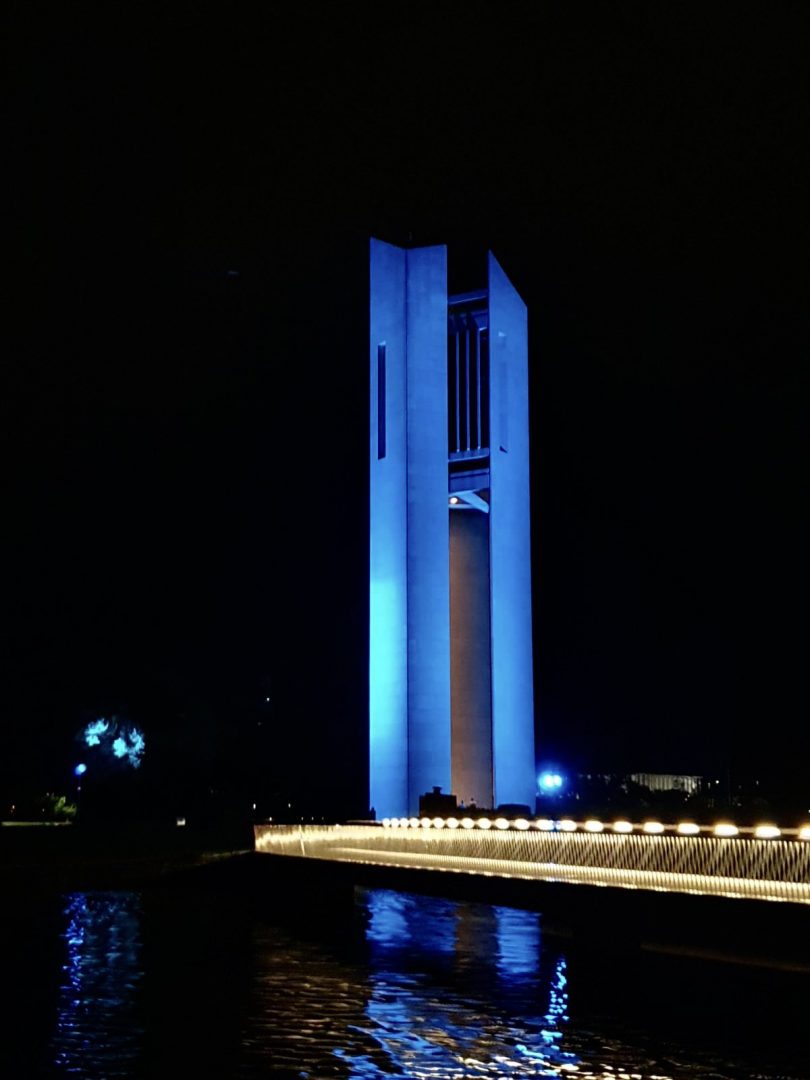
The Carillon glowed blue last night to celebrate the Territory’s vax milestone. Photo: ACT Health.
On the changes to retail, Dr Coleman echoed the Chief Minister, saying she was more comfortable with easing retail restrictions now that the Territory’s full vaccination rates had reached extremely high levels.
However, she conceded that the practicalities of “being an island within NSW had implications for needing to provide consistency”, and she had engaged with her NSW counterpart Dr Kerry Chant to better align the two jurisdictions’ approach.
She also said health advice was constantly changing in response to new evidence but suggested it was very likely that no further changes would be implemented before next Friday.
“I will be interested in seeing how NSW, Victoria and ourselves respond to the 80 per cent changes, and we will need 14 days to see how that pans out,” she added.
A particular focus on schools would also be necessary, Dr Coleman said, given under-12s are now the largest unvaccinated cohort.
“This isn’t over, and the next four to six weeks are going to be critical as we see how this unfolds.”
Dr Coleman also provided an update on the epidemiology of the current outbreak.
The ACT this week recorded 230 new cases of COVID-19 while 238 cases recovered. Just over 50 per cent of these cases present no risk of community transmission.
A drop in the daily testing numbers was also noticeable, Dr Coleman said. At the start of this outbreak, testing numbers had averaged 3000 a day, but that number had now fallen to an average of just over 1600 each day over the last two days.
She noted some of these lower testing numbers could be attributed to less reporting of exposure locations and fewer Canberrans having tests mandated as a close or casual contact.
While Dr Coleman said she had no magic number regarding the perfect amount of tests, she did encourage anyone with symptoms to get tested. She expected that as the return to school and work gets underway, common colds and usual viruses would spread. She hoped anyone with these symptoms would get tested.
The median age for the ACT’s cases is still 27 years old, and just over half of all cases are male.
As the Territory’s vaccination rates have increased, the proportion of unvaccinated cases per week has decreased. At the start of the outbreak, 80 per cent of all cases were unvaccinated. Now, 50 per cent of cases are unvaccinated.
Dr Coleman said this was expected. Breakthrough infections had also risen from 4 per cent per week at the start of the outbreak to 14 per cent last week.
Since the start of the outbreak, 128 people – or 8.5 per cent of all cases – have been hospitalised, ranging in age from one to over 95 years old.
There have been 31 people in ICU and 17 have required ventilation.
The age range of cases admitted to the ICU is 24 to 68 years.
The vast majority of cases admitted to hospital continue to be unvaccinated, she said.
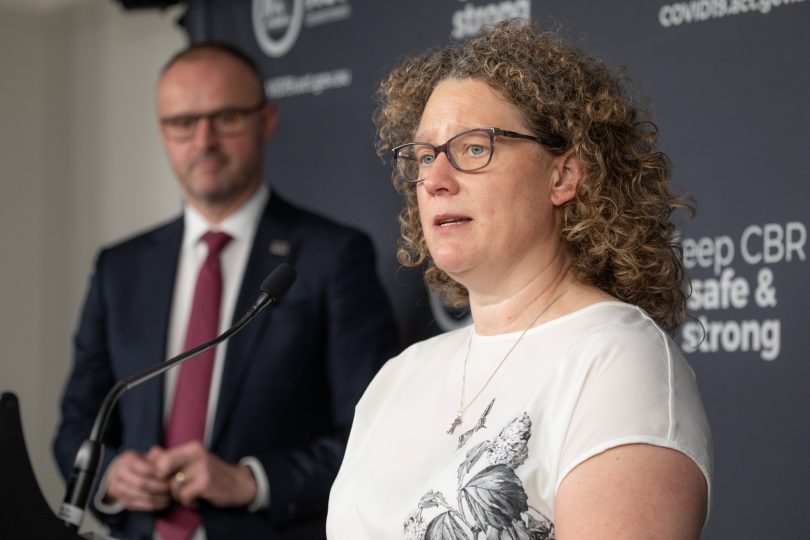
Chief Health Officer Dr Kerryn Coleman provided an update on the ACT’s outbreak today. Photo: Michelle Kroll.
Total deaths for the outbreak now stand at 8, and 15 per cent of all positive cases are still unlinked.
“With more people moving around the community, we will see more community transmission, and we will see case numbers rising,” Dr Coleman said.
She flagged changes to the ACT’s reporting on positive cases from next week, as well as a scaling back of contact tracing.
There will no longer be a focus on linking all cases and the proportion of unlinked cases won’t be reported on anymore.
Instead, the focus will be on cases where transmission in the community will be rapid or where vulnerable people are more likely to be exposed in settings like healthcare, aged care, workplace exposures and indoor venues.

Canberra’s landmarks lit up blue in celebration of the major vaccine target hit last night. Photo: ACT Health.
UPDATED 11 am: The ACT has recorded 24 new COVID-19 cases to 8 pm last night.
Yesterday there were 17 new cases.
Of the new cases, 21 are linked to known cases or ongoing clusters. There are 428 active cases in the ACT.
There are 18 patients in ACT hospitals with COVID, including 10 in intensive care.
Last night the ACT passed the 80 per cent fully vaxed milestone for people aged 12-plus (officially 80.7 per cent).
In NSW there were 273 new COVID cases and four more deaths.
Yesterday there were 265 new cases and four deaths.
NSW Health has also revealed that infections in the youngest cohorts are now outstripping other age cohorts.
Officials say almost 600 children have fallen ill with COVID in the past week in NSW.
On 13 October, the TGA announced that vaccine manufacturer Pfizer was eligible to apply to vary the provisional approval for the vaccine to include children aged 5 to 11 years.
Victoria has recorded new 1749 Covid cases and 11 deaths.
Yesterday the state had 1903 new cases and seven deaths.

ACT retailers and the Opposition have criticised the Government after it relaxed the border rules, allowing Canberrans to spend their dollars interstate rather than at local businesses. Photo: Thomas Lucraft.
Having hit the milestone of 80 per cent full vaccination yesterday (18 October), the ACT Government has announced some changes to the pathway forward, including the resumption of retail trade from Friday.
At 11:59 pm on Thursday, 21 October, all retail, including essential businesses currently operating under a click and collect or click and deliver models and non-essential retailers, can recommence operations from Friday with capacity limits of one person per four square metres.
As already signalled, further restrictions will be eased from 29 October.
From this date, capacity limits across a number of different industries including hospitality and major events will be relaxed and food courts will also be able to reopen under the same one person per four square metres rule and face masks will no longer be mandatory outdoors.
From 1 November, subject to the public health risk at the time, the ACT will remove the declaration of NSW as a COVID-affected area, and will align its quarantine arrangements for overseas arrivals with that of NSW.
When NSW is removed as a COVID-affected area, quarantine free travel to and from Greater Sydney as well as the rest of the state will be possible for Canberrans.
In the ACT, baseline public health safety measures are expected to continue throughout November and December, including keeping hospitality density limits at one person per two square metres.
The ACT is now the only jurisdiction in the country to have hit 80 per cent double dose for the population aged 12 and above. Landmarks around the Territory including the Telstra Tower, and the National Carillon glowed blue or ‘vaccine aqua’ last night in celebration of the feat.
In a post on his Twitter yesterday, Chief Minister Andrew Barr foreshadowed some changes being made today.
The ACT Government came under fire from the Opposition and the business community over the weekend for its ‘border backflip’ which ostensibly allowed Canberrans to cross the border to shop.
Non-essential retailers in NSW are allowed to operate, while those in the ACT remain under extremely tight operating conditions.
In NSW, of course, only fully vaccinated customers can visit any non-essential retailers.
Speaking this morning on breakfast radio, Health Minister Rachel Stephen-Smith said changes to the NSW border rules had created ‘inconsistencies’ in the two states’ approach.
In accordance with the National Plan, the ACT is no longer listed as a hotspot as of 11:59 pm last night, and the Commonwealth funding tap will be even further turned off.
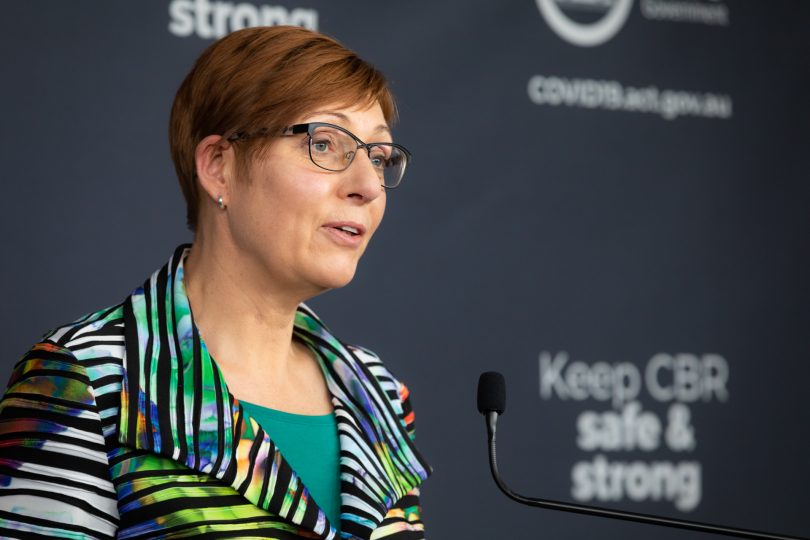
Minister for Health Rachel Stephen-Smith encouraged anyone with even the mildest of symptoms to get tested. Photo: Michelle Kroll.
Ms Stephen-Smith yesterday reiterated concerns over the low testing numbers currently being recorded and suggested these may be due to fewer exposure sites being identified.
She urged anyone with “even the mildest of symptoms” to come forwards and get tested, saying that if you were infected with COVID-19 and wait until you’re sick enough to need to attend Emergency, the treatment options available to you would be greatly limited.
“Get tested … for peace of mind or so you find out you have COVID-19 and a treatment plan can be commenced straight away,” she said.
The Minister also called for patience as the last few thousand Canberrans – particularly younger cohorts – come forward to receive their second doses in the coming weeks.
Amid concerns over an inaccurate population denominator, the ACT has also stopped recording first dose vaccination rates as the milestone of 99 per cent of the eligible population being jabbed has now been passed.
New dates and times of concern for the early childhood centre and construction site already listed as close contact exposure sites were added to the ACT Government’s COVID-19 website yesterday evening.
The construction site at Campbell Primary School is now a close contact site on Friday, 8 October, between 6:30 am and 5:30 pm. It’s also listed as a venue of concern from Monday, 11 October to Thursday, 14 October between 6:30 am and 5:30 pm.
On Friday, 15 October, the construction site is listed as a close contact site between 6:30 am and 3 pm, and between 6:30 am and 12:30 pm on Saturday, 16 October.
The Grass Parrot Room and Kangaroo Room at the Narrabundah Early Childhood School is a close contact site on Wednesday, 13 and Thursday, 14 October between 9 am and 3:30 pm.
While there are still 108 active exposure locations, very few new locations have been listed since the ACT’s hard lockdown ended on Friday, 15 October, reflecting a change in public health policy.
See the ACT Government’s COVID-19 website for specific exposure times and dates as well as instructions to follow as a close contact.
As life returns to ‘COVID-normal’, the ACT Government announced yesterday that speed vans in residential areas will start to return, and free parking will end at the beginning of next month.
Libraries ACT will reopen its Belconnen, Gungahlin and Tuggeranong branches with reduced hours from Wednesday, and Access Canberra centres will also begin to reopen.
Some changes to public transport will also occur in the coming weeks with the full school bus timetable to resume on Monday, 25 October as more students return to school.












